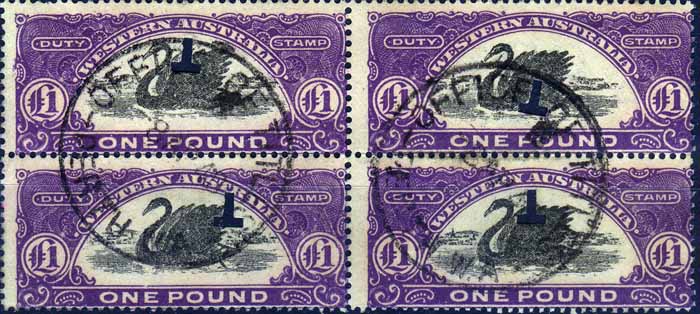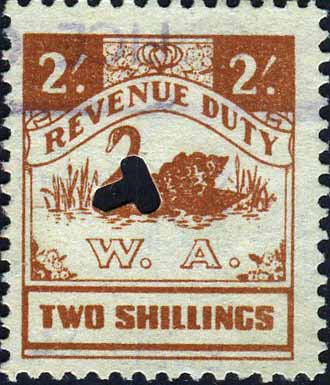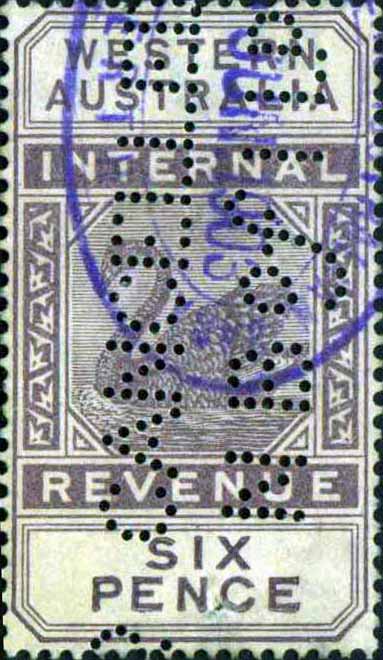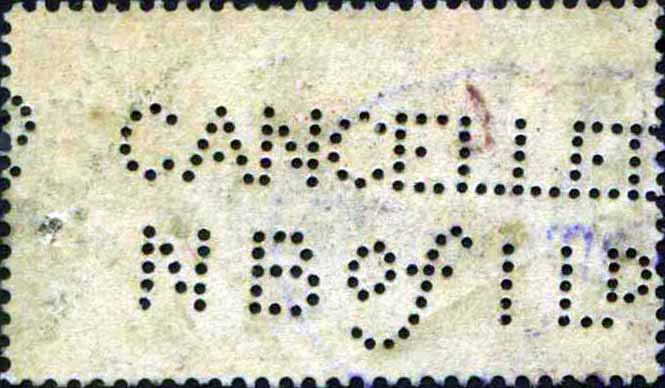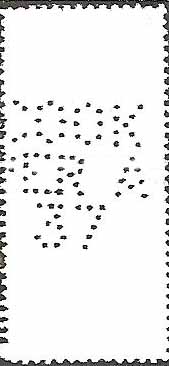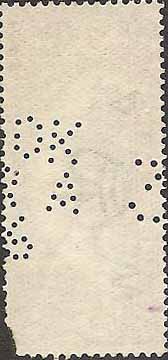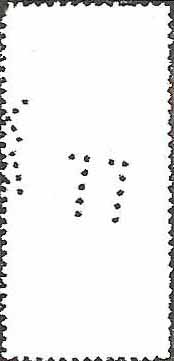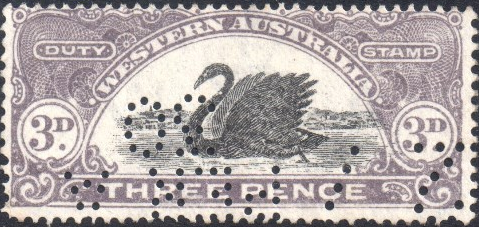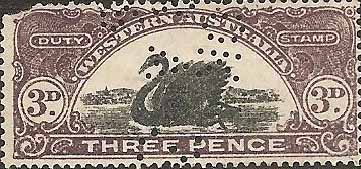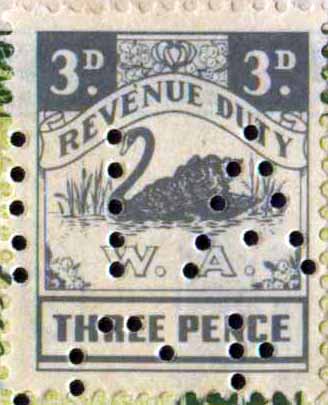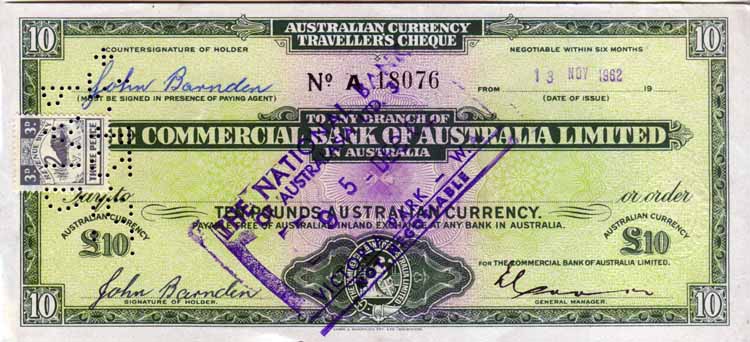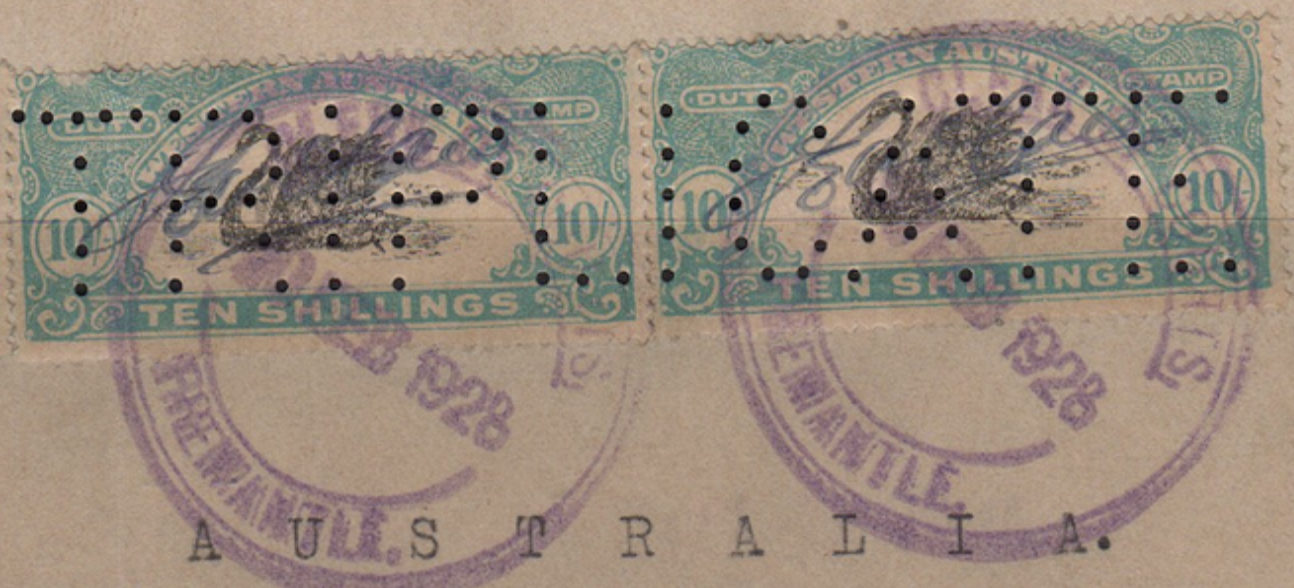|
Private Revenue Perfins of Western Australia An Elsmore Coath production The authors would welcome your comments additions or input into this work C D F G H I K L M N O P R V W Other Other -------------------------------------------------------- Section 1 - Other Perfins Section 2 - Commercial Overprints -------------------------------------------------------- ------------------------------------------------------------------------------------------------- ------------------------------------------------------------------------------------------------- Section 1 - Other Perfins ------------------------------------------------------------------------------------------------- ------------------------------------------------------------------------------------------------- Treasury Punch
.a 4½x4mm .b 4½x4mm .c 5x4½mm .d 4x4mm Four different devices have been identified. ---- T.a
User: State Government Western Australia
Address: Treasury Perth, WA.
Revenue Use:
1922 issue: 5/-, 10/-, 15/-, £1, £5, £10.
1923 issue: (Zinc Plates): 1/-, £1, £5.
1941 issue: 2/-, 2/6d, 5/-, 10/-, 15/-, £1, 30/-, £5.
1943-1965 issues: 2/-, 5/-, 10/-, £1, 30/-.
Rarity Scale:
1922 issue: 5/- R3, 10/- R3, 15/- R3, £1 R2, £5 R4, £10 R4.
1923 issue: (zinc plates) 1/- R2, £1 R2, £5 R4.
1941 issue: 2/- R3, 2/6d R3, 5/- R2, 15/- R4, £1 R3, 30/- R4, £5 R4. 1943-1965 issues: 2/- R2, 5/- R2, 10/- R1, £1 R2, 30/- R3. Background: Government cancellations of all instruments under the Stamp Act of 1881 (7 April 1881) were as follows: From 1881 to 1892 adhesive revenues were manuscript cancelled to legalise an instrument. From the advent of the rubber stamp cancelling device c1892, this was deemed an additional form of cancelling to legalise an instrument so long as it was accompanied by the signature of the official and the date. In c1932 a T (T for Treasury) punch was introduced. This 'Ledger Punch', was officially described as a "Perforating Machine". This punch can be found with no other markings on revenues. The practice of this type of cancel was discontinued 1 Jan 1980.
Device: Cancelling device.
Related patterns: Refer to other Treasury punctures in:
WA Other - Section 1 Other Perfins: T.b T.c T.d -------------------------------------------------------- T.b
User: State Government Treasury Western Australia
Address: Treasury, Perth, WA.
Revenue Use:
1943-1965 issues: 2/-, 30/-, £5, £10.
Rarity Scale:
1943-1965 issues: 2/- R4, 30/- R3, £5 R4, £10 R4.
Background: See T.a above
Device: Cancelling device.
Related patterns: Related patterns: Refer to other Treasury punctures in:
WA Other - Section 1 Other Perfins: T.a T.c T.d -------------------------------------------------------- T.c
User: State Government Treasury Western Australia
Address: Treasury, Perth, WA.
Revenue Use:
1930 Hospital Fund issue 1½d, 3d[orange].
1931 Financial Emergency Tax issue 4d, 1/-.
1941 issue: 2/-, 2/6d, 5/-, 10/-, 15/-, £1, 30/-, £5.
1943-1965 issues: 3d, 6d, 1/-, 2/-, 2/6d, 5/-, 10/-, £1, £10.
1966 issue: Cream Paper: $10, $20.
White Paper: 20c, 25c, 25c (double print), 50c, $1, $2, $5, $10, $20, $50.
Rarity Scale:
1930 Hospital Fund issue 1½d R1, 3d R1.
1931 Financial Emergency Tax issue 4d R1, 1/- R1.
1941 issue: 2/- R2, 2/6d R3, 5/- R1, 10/- R1, 15/- R4, £1 R3, 30/- R2, £5 R3.
1943-1965 issues: 3d R3, 6d R1, 1/- R1, 2/- R2, 2/6d R3, 5/- R1, 10/- R1, £1 R2, £10 R4.
1966 issue: Cream Paper: $10 R2, $20 R4.
White Paper: 20c R2, 25c R2, 25c (double print) R4, 50c R1, $1 R1, $2 R1, $5 R1, $10 R1, $20 R1, $50 R4.
Background: See T.a above
Device: Cancelling device.
Related patterns: Related patterns: Refer to other Treasury punctures in:
WA Other - Section 1 Other Perfins: T.a T.b T.d -------------------------------------------------------- T.d
User: State Government Treasury Western Australia
Address: Treasury, Perth, WA.
Revenue Use:
1949-1965 issue: 2/-, 2/6, £10.
Decimal Use:
1966 issue: 10c, 20c, 25c, 50c, $1, $2, $5, $10, $20.
Rarity Scale:
1943-1965 issues: 2/- R2, 2/6d R3, £10 R4.
1966 issue: 10c R1, 20c R1, 25c R2, 50c R2, $1 R1, $2 R1, $5 R1, $10 R1, $20 R1.
Background: See T.a above
Device: Cancelling device.
Related patterns: Related patterns: Refer to other Treasury punctures in:
WA Other - Section 1 Other Perfins: T.a T.b T.c -------------------------------------------------------------------------------------------------
Cancelling Devices
------------------------------------------------------------------------------------------------- CANCELLED/N B of I Ld.a User: National Bank of India Ltd
Bank
Address: Offices in: Bombay India & London UK Revenue Use: 1903 issue 6d. Rarity Scale:
1903 issue: 6d R3.
Background: *The Calcutta City Banking Corporation was formed in 1863 as an Indian registered bank, changing its name to the National Bank of India (NBI) a few months later. Offices in London and Bombay followed in 1864 and 1865. Crucial to the Bank’s future, its head office was transferred to London in 1866 and the Company was registered under the UK Companies Act, giving it much greater international potential, but it was a move that was fiercely contested for many years.
NBI remained with these three offices until 1870 when it sought to exploit opportunities in China with a branch in Hong Kong and, later, in Shanghai. Substantial losses threatened the Bank and the Chinese operations were eventually closed. Without neglecting its domestic market, NBI began to expand around the fringes of the Indian Ocean, particularly Aden and East Africa; by 1900 NBI had 19 branches and £10m of assets.
Steady expansion continued through the early 1900s and by the outbreak of World War I NBI was the seventh largest of the London-registered overseas banks. Growth continued during the War and by 1918 the Bank’s assets were £33m with record profits of over £400,000. Around that time, detailed discussions took place with Lloyd's Bank and agreement was reached in principle for Lloyd's to acquire NBI but, according to the Bank’s official history, the proposal was vetoed by ‘the authorities’.
The inter-war years saw NBI stagnate, only two new branches were opened and there was no growth in the Bank’s assets. More substantial change was to come after the Second World War. In August 1947 India was granted independence with all the turmoil that entailed in the Bank’s main market. Undaunted, the following year NBI purchased Grindlays Bank from National Provincial Bank; Grindlays then had deposits of around £20m compared with over £70m for NBI.
Device: *1 This cancelling device (type II) can be found recorded between 1883-1914. Applied in London by the National Bank of India Ltd upon receiving Foreign Bills. In this case the Western Australia adhesive traveled to London ‘rubber stamped’ only, with the cancelling device applied upon bill payment.
Type I 1882-1906 shows ‘stops’ and 5 holes on top of F.
Type II 1883-1914 identified by no ‘stops’ and 4 holes on top of F.
*Wikipedia
*1 'The Perfined Revenues Stamps of Great Britain' by The GB Perfin Society -------------------------------------------------------- COOK.a
* *
User: Thomas Cook & Sons
Tourist Travel & Shipping Agency
Address: Opposite GPO Perth, WA. Revenue Use: 1922-1930 issue: 3d, 2/6d. 1923-1925 zinc plate issue: 1d, 2d, 3d. Rarity Scale:
1922-1930 issue: 3d R4, 2/6d R4.
1923-1925 zinc plate issue: 1d R4, 2d R4, 3d R4.
Background: Thomas Cook was born in Derbyshire, England in 1808 and after a period as a gardener and apprentice cabinetmaker, in 1826 he became an evangelist and later in 1828 a Baptist Minister. In 1832, Cook moved to Market Harborough in Leicestershire where he married Marianne Mason (1933) and their only son John Cook was born in January 1834. Thomas was very committed to the Temperance movement. In 1841 he arranged for a group of 540 temperance campaigners to travel to a rally and in doing so arranged a discount fare with the rail operator and Cook was paid a share of the total fare. From 1844 Cook expanded these tours and this success led him to start his own business running rail excursions for pleasure.
He expanded into accommodation taking 350 people from the Midlands on a tour of Scotland however this resulted in his bankruptcy. However he persisted and claimed to have arranged for over 165,000 people to attend the Great Exhibition in London in 1851. This lead to his first overseas tour to Calais (1855) to coincide with the Paris Exhibition. The following year he started his 'grand circular tours' of Europe and later in the 1860s he took parties to Switzerland, Italy, Egypt and the United States. At this time Cook formed a partnership with his son John named Thomas Cook and Son, Travel Agents and they acquired premises on Fleet St, London. The company stopped personal tours and became an agent for foreign or domestic travel as well as selling travel accessories such as guidebooks, luggage, telescopes and footwear. After a brief business expansion into the United States in the late 1860’s in 1872 Cook started to offer a round the world tours for just 200 guineas that included a steamship across the Atlantic, a stage coach across America, a paddle steamer to Japan and an overland journey across China and India, lasting 222 days. In 1874, Thomas Cook introduced 'circular notes', a product that later became better known by American Express's brand as Travellers Cheques. After some disagreements in the partnership Thomas retired in 1879 and returned to Leicestershire and lived quietly until his death in 1892. The company continued to grow under John’s management with his 3 sons, and this included expansion into military transport and postal services for Britain and Egypt. By 1888, the company had established offices around the world, including three in Australia and one in New Zealand. John Cook died in 1899 after contracting dysentery while in Palestine. The company was taken over by his sons, Frank, Thomas (jnr) and Ernest however they were not very successful as their father and grandfathers and by 1928 the company was sold to a Compagnie Internationale des Wagons-Lits (International Sleeping-Car Company). After WWII the company was nationalised as part of the British Transport Commission. The company experienced difficulties in the early 1970’s and was rescued by a consortium of Banks before being broken up with the US operations being sold to Dun and Bradstreet in 1975. The company has prospered and has passed through many corporate hands as a result of mergers and takeovers and is still trading today as Thomas Cook Group Pl. Device: As reported in the South Pacific Perfin Bulletin #57 these Perth patterns were from a Thomas Cook device that is known to have been used in November 1937. The layout of the pattern is similar to other devices used by the company in their offices around the world. Some of these devices have been known to have been made by Slopers.
The format of the pattern is Cook/date, location, month/Year, in this case the location is ‘Per’ (Perth) and ‘A’ (Australia). A similar device is known from Sydney.
Thomas Cook were frequent perfin users and their patterns are found on the postage stamps of many countries including England, India, Egypt and Hong Kong in formats of TC/&S, TC/S and TC. The only Australian usage on postage stamps is limited to series of batches of service punctures on postage stamps of Victoria, in the format TC/&S, found used between 1895 and 1898. Although these are in the Postage and Stamp Duty period of Victoria in which the same stamps could be used for both purposes true revenue use is not known.
Related Patterns:
NSW: Other - Section 1 Cancelling Devices: Cook.a
*eBay * Wikipedia and “History of Leisure” by Rudy Koshar
-------------------------------------------------------- PAID.a
User: Unknown Revenue Use: 1943-1957 issue: 2d Rarity Scale:
1943-1957 issue: 2d R1.
Background: Unknown
Device: This is clearly a partial strike of a larger pattern. The 9 corresponds to the handwritten date of the stamp so this suggests that the device is a cancelling type device with a date included in the pattern. It is possible that that the pattern also included other details in addition to the date, such as the word "PAID".
The numeral is
characterised by the rounded shape rather than the
straight sided and "digital" style numerals. Given
the rounded shape of the numerals it is most
likely that this device allowed dies of different
numbers to be inserted into the punch head.
It is possible that other straight-sided number
sets may have been created by adjusting rows of
pins or indeed individual pins to create a given
numeral. -------------------------------------------------------- PAID.b
User: Unknown Revenue Use: 1922-1930 issue: 2d. Rarity Scale:
1922-1930 issue: 2d R1.
Background: Unknown
Device: Another cancelling device in the common format with date and the word "PAID". This is a different style to the device above (PAID.a) as it has fewer and larger pins in the numerals. The letters a 4 pins high.
Related patterns: Nil -------------------------------------------------------- PAID.c
User: National Bank of Australia Ltd
Address: Victoria Park, Perth, WA Revenue Use: 1951-1963 issue: 3d. 1966 issue: 5c, 6c. Rarity Scale:
1951-1963 issue: 3d R1.
1966 issue: 5c R1, 6c R1.
Background: *The National Australia Bank was founded in Victoria in 1858 and early growth was based in the States of Victoria and South Australia. Gradually over the years, it expanded and absorbed a number of other banking institutions in Australia. These include the Colonial Bank of Australasia (1918), the Bank of Queensland (1922), the Queensland National Bank (1948) and the Ballarat Banking Company (1955). The National cemented its place in the top four banks in Australia with the 1981 merger with the Commercial Banking Company of Sydney. Device: This
strike shown cancelling a travellers cheque
clearly indicates how a partial pattern can be
formed on a stamp. The letter style is 5 pins
high. It is interesting to note that the numerals
in the second line are +7.12.62 which is
consistent with the date of the traveller’s cheque
of 13 November 1962 and cancelling by the cachet
on 5 December 1962. The 2 in 62 is not well formed
and in some ways not consistent with the numeral 2
in the month (12). This may indicate that the
device allowed the user to set the date from a
bank of pins rather than inserting specific
numeral dies into the punch head.
* NAB website -------------------------------------------------------- T.e
User: Commonwealth Trading Bank of Australia
Address: Perth, WA Revenue Use: T punch Rarity Scale: T punch
Background: *The Commonwealth Bank of Australia (later CBC) was founded by the Commonwealth Bank Act in 1911 and it was the first bank to receive a Federal Government guarantee. The first branch was opened in Melbourne in July 1912 and by an arrangement with the then Postmaster Generals Department (now Australia Post), that still exists today; they also traded through post office agencies. In 1912 it merged with the state savings bank in Tasmania and in 1920 state savings bank of Queensland. From 1920 the CBC acted as the Central Bank in Australia which included the issuing of bank notes however this was a controversial role.In 1931 the bank absorbed the Government Savings Bank of New South Wales (est.1871), and parts of the Rural Bank Department. And the State Savings Bank of Western Australia (est.1863). In the late 1950’s the controversy regarding the dual roles of the bank was addressed by the creation of the Reserve Bank of Australia which took over the central bank functions leaving the CBC with just its commercial banking functions. These functions were undertaken by the CBC’s constituent banks, the Commonwealth Trading Bank of Australia (CTB), the Commonwealth Savings Bank of Australia (CSB) and the newly formed Commonwealth Development Bank (CDB). In 1989 the bank acquired a controlling interest in the ASB Bank of New Zealand and in 1991 CBC took over the State Savings Bank of Victoria.Between 1991 and 1996 the Australian government fully privatised the CBC into a publically listed company. Device: Unknown.
Related patterns: Refer to other letter patterns on cheques in:
QLD: Other - Section 1 Commercial Overprints: B.a
SA: Other - Section 1 Commercial Overprints: B.a
* Commonwealth Bank website -------------------------------------------------------- TRIPLICATE.a
User: W A
Government Revenue Use: 1922-1930
issue - Complete: 10/-. Rarity Scale:
1922-1930 issue -
Complete: 10/- R3.
Background: Unknown
-------------------------------------------------------- ------------------------------------------------------------------------------------------------- ------------------------------------------------------------------------------------------------- Section 2 - Commercial Overprints ------------------------------------------------------------------------------------------------- ------------------------------------------------------------------------------------------------- -------------------------------------------------------- The links below take you into the Commercial Overprint section of the book -------------------------------------------------------- C D F G H I K L M N O P R V W Other Commercial Overprint States FULL index © copyright 2011 |




